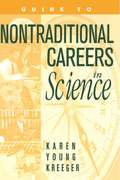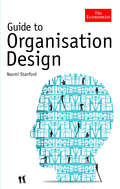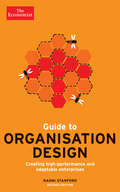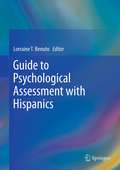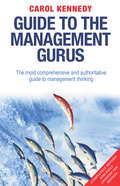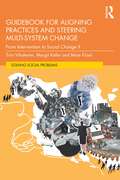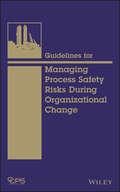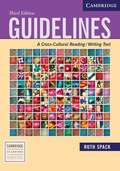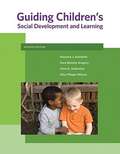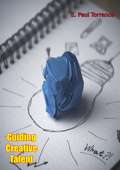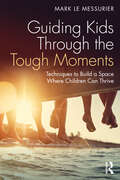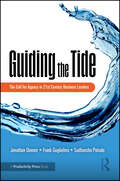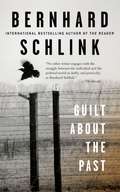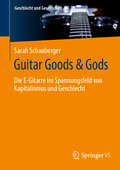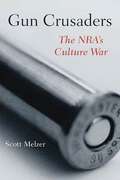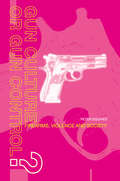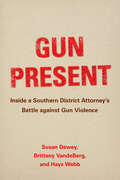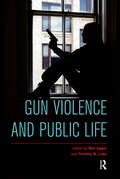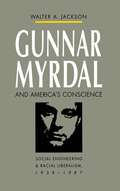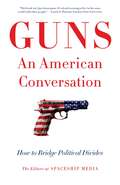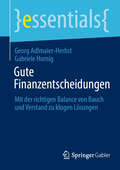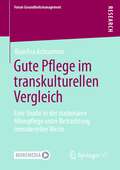- Table View
- List View
Guide to Non-Traditional Careers in Science: A Resource Guide for Pursuing a Non-Traditional Path
by Karen Y. KreegerOffering practical advice and stories from scientists and professionals, this guidebook aids the reader in evaluating and finding career opportunities in non-academic research fields. It demonstrates that choices are available, providing many examples of fields (for example publishing, law, public policy and business) in which people can use their scientific training to nurture a satisfying professional life. Yet it also acknowledges that there are trade-offs involved with any veer from the traditional path.
Guide to Organisation Design
by Naomi Stanford The EconomistBusiness failure is not limited to start ups. "Industry Watch" (published by BDO Stoy Hayward, an accounting firm) 'predicts that 17,043 businesses will fail (in the UK) in 2006, a further 4 per cent increase from 2005'. In America between 1990 and 2000, there were over 6. 3 million business start-ups and over 5. 7 million business shut-downs. Risk of failure can be greatly reduced through effective organisational design that encourages high performance and adaptability to changing circumstances. Organisation design is a straightforward business process but curiously managers rarely talk about it and even more rarely take steps to consciously design or redesign their business for success. This new Economist guide explores the five principles of effective organisation design, which are that it must be: driven by the business strategy and the operating context (not by a new IT system, a new leader wanting to make an impact, or some other non-business reason); involve holistic thinking about the organisation; for the future rather than for now; not to be undertaken lightly - it is resource intensive even when going well; and, seen as a fundamental process not a repair job. (Racing cars are designed and built. They are then kept in good repair. )
Guide to Organisation Design
by Naomi StanfordBusiness failure is not limited to start ups. Industry Watch (published by BDO Stoy Hayward, an accounting firm) 'predicts that 17,043 businesses will fail (in the UK) in 2006, a further 4 per cent increase from 2005'. In America between 1990 and 2000, there were over 6. 3 million business start-ups and over 5. 7 million business shut-downs. Risk of failure can be greatly reduced through effective organisational design that encourages high performance and adaptability to changing circumstances. Organisation design is a straightforward business process but curiously managers rarely talk about it and even more rarely take steps to consciously design or redesign their business for success. This new Economist guide explores the five principles of effective organisation design, which are that it must be: driven by the business strategy and the operating context (not by a new IT system, a new leader wanting to make an impact, or some other non-business reason). involve holistic thinking about the organisation be for the future rather than for now not to be undertaken lightly - it is resource intensive even when going well be seen as a fundamental process not a repair job. (Racing cars are designed and built. They are then kept in good repair. )
Guide to Organisation Design: Creating high-performing and adaptable enterprises (Economist Books)
by Naomi StanfordBusiness failure is not limited to start ups. Industry Watch (published by BDO Stoy Hayward, an accounting firm) 'predicts that 17,043 businesses will fail (in the UK) in 2006, a further 4 per cent increase from 2005'. In America between 1990 and 2000, there were over 6. 3 million business start-ups and over 5. 7 million business shut-downs. Risk of failure can be greatly reduced through effective organisational design that encourages high performance and adaptability to changing circumstances. Organisation design is a straightforward business process but curiously managers rarely talk about it and even more rarely take steps to consciously design or redesign their business for success. This new Economist guide explores the five principles of effective organisation design, which are that it must be: driven by the business strategy and the operating context (not by a new IT system, a new leader wanting to make an impact, or some other non-business reason). involve holistic thinking about the organisation be for the future rather than for now not to be undertaken lightly - it is resource intensive even when going well be seen as a fundamental process not a repair job. (Racing cars are designed and built. They are then kept in good repair. )
Guide to Psychological Assessment with Hispanics
by Lorraine T. BenutoThis book focuses on diversity, culture, and ethnicity as they relate to psychological assessment of Hispanics. It is a how-to guide for clinicians, researchers, and instructors working with Hispanic clients. Each chapter contains an overview of cultural considerations needed for assessing the Hispanic client followed by a specific exploration of the assessment measures available and the research that has been conducted on these measures with Hispanic participants. An exploration of the strengths and limitations of each assessment measure is included. Considering that ethnocultural minority individuals who are of Hispanic/Latino origin make up the largest ethnocultural minority group in the United States, guidelines for working with this population are a must. Given that a large subset of this percentage is composed of immigrants many of whom do not speak English or who have learned English as a second language, special considerations for effective psychological assessment are neccessary.This book fills a gap in the scientific literature by consolidating the research on psychological assessment with Hispanic samples into one comprehensive volume and providing simple recommendations for the psychological assessment of Hispanic clients. An exploration of the general psychological assessment domains (e.g., personality, intelligence) is included with references to research on the major assessment measures used in the field. A more specific exploration of psychodiagnostic assessment measures follows, including the assessment of mood disorders, anxiety disorders, sexual dysfunction, psychosis, etc. Several chapters are dedicated to specialized assessment, including neuropsychological assessment, forensic assessment, and school-based assessment, overall creating the most comprehensive, up-to-date, research-based compendium of psychological assessment measures for use with Hispanic clients.
Guide to the Management Gurus 5th Edition
by Carol KennedyThe fifth edition of the original, best-selling guide to the ideas of leading management thinkers. The ten additional full-length entries range from classic gurus such as Henry Gantt and the Gilbreth time-and-motion pioneers to the latest thinkers influencing 21st-century business, including Clayton Christensen, master of innovation theory, and Karen Stephenson with her ground-breaking insights into human networks.The lives and work of more than 55 gurus are covered in clear and accessible style, along with penetrating analysis of their ideas and influence on management. Guide to the Management Gurus has sold around the world since its first publication in 1991, and has been translated into more than 15 languages, including Russian, Chinese, Korean and Japanese.
Guidebook for Aligning Practices and Steering Multi-System Change: From Intervention to Social Change II (Solving Social Problems)
by Margit Keller Triin Vihalemm Maie KiiselBuilding on the work of the authors’ previous volume, the Guidebook for Aligning Practices and Steering Multi‑System Change translates cutting‑edge theoretical concepts into the language and applied toolkits of change practitioners. This empirically grounded and theoretically sophisticated book provides policymakers and change‑managers methods and toolkits for conceptual modelling of change when handling cross‑sectoral issues. The authors both ‘zoom in’ to the granular unfolding change of everyday life and ‘zoom out’ to examine the ‘big picture’ of socio‑technical systems such as energy, mobility, food and healthcare. In addition to the social practice theories introduced in the first volume, the authors draw on the multi‑level perspective that underpins sustainability transition studies and combine two theories. They are also inspired by the Deep Transition concept that tackles multi‑systems change. Bridging the gap between the theorisation of sustainability transitions and practical guidelines, it will appeal to policymakers, sustainability project managers and students of management, social and political sciences, technology and innovation.
Guidelines for Managing Process Safety Risks During Organizational Change, 1st Edition
by CcpsAn understanding of organizational change management (OCM) -- an often overlooked subject -- is essential for successful corporate decision making with little adverse effect on the health and safety of employees or the surrounding community. Addressing the myriad of issues involved, this book helps companies bring their OCM systems to the same degree of maturity as other process safety management systems. Topics include corporate standard for organizational change management, modification of working conditions, personnel turnover, task allocation changes, organizational hierarchy changes, and organizational policy changes.
Guidelines: A Cross-Cultural Reading/Writing Text (Third Edition)
by Ruth SpackAn advanced reading and writing text designed specifically to strengthen students' academic writing. The cross-cultural readings in Guidelines offer a wide range of thought-provoking subject matter, varying in genre, viewpoint, length, and style. As students respond to the readings and work their way through the writing assignments, they are assisted by strategies laid out in 'Guidelines' boxes and by examples from other student writers. Writing assignments include research writing and essays that synthesize sources, critique arguments, and analyze fiction. A handbook is included as a reference guide in the back of the book. It contains sections on documenting sources, drafting and revising, and correcting grammatical errors. Guidelines, Third edition, is a major revision. The readings have been updated, the chapters are easier to navigate, and the 'Guidelines' now include references to the Internet as a means of research.
Guides to the Coinage of the Ancient World: The Hellenistic World
by Peter ThonemannCoinage is one of our key sources for the rich and fascinating history of the Hellenistic world (323–31 BC). This book provides students of the period with an up-to-date introduction to Hellenistic gold, silver and bronze coins in their cultural and economic contexts. It also offers new perspectives on four major themes in contemporary Hellenistic history: globalisation, identity, political economy and ideology. With more than 250 illustrations, and written in a lucid and accessible style, this book sheds new light on the diverse and multicultural societies of the Hellenistic world, from Alexander to Augustus. The author assumes no prior knowledge of Hellenistic history, and all Greek and Latin texts are translated throughout.
Guiding Children's Social Development and Learning (Seventh Edition)
by Marjorie Kostelnik Kara Gregory Anne Soderman Alice WhirenGUIDING CHILDREN'S SOCIAL DEVELOPMENT AND LEARNING, Seventh Edition, focuses on ways professionals can help children develop both positive feelings about themselves and social competence. Readers will find practical, developmentally appropriate strategies for how to work with children and families from many different backgrounds and circumstances, and in a variety of group settings. And, they'll obtain a unified framework for decision-making and professional practice that incorporates sound principles of children's development, relationship enhancement, and behavior management.
Guiding Creative Talent
by E. Paul TorranceAnyone with an interest in the problems of highly creative children will find this volume useful in guiding a wide range of creative talent at all age and educational levels. In preparing this material, I have drawn most heavily upon my own research and that of my colleagues concerning the creative thinking of children, adolescents, and adults. Although my emphasis is upon the problems of highly creative children, I believe you will find these materials useful in guiding a wide range of creative talent at all age and educational levels. I have also attempted to give these research findings and observations meaning from my experience as a teacher, counselor, and principal in a high school and as a college teacher and counselor, roles in which I have met many highly creative individuals. I have also drawn upon my research concerning behavior under emergency and extreme conditions, especially situations involving coercion.
Guiding Kids Through the Tough Moments: Techniques to Build a Space Where Children Can Thrive
by Mark Le MessurierFamilies, classrooms, all kinds of human groups are intricate, evolving social and emotional worlds. They exist to protect and nourish but living in them is not always easy. And, when one of us is not doing well, none of us are. This makes them a delicate, dynamic, messy, and endless work in progress. This book centres around those moments when we must get involved, or call a child out on an unsafe, careless, or selfish action. Pitched well beyond the superficiality of making "happy families" or "obedient classes," this book dives into the colour and chaos of life. It provides guidance for navigating the commotion and the processes, as well as the grit required in the tougher moments. It’s these moments that reveal what is really happening between children and their parents, educators, or carers. The book outlines a special set of attitudes and skills described as using our "soft eyes and warm hearts." In this space, we hold a child or teen accountable using an almost counterculture mindset. One that connects leadership and strength directly with kindness. This humane approach is more likely to leave young people in a position where they might want to feel responsible, make amends and changes, rather than being forced to. If we are to improve our relationships, outcomes, and futures with this generation of kids we must commit to truthful conversation, reflection, and preparation. Written by trusted author Mark Le Messurier, an experienced teacher, counsellor and public speaker, this is an essential guide for parents, carers, teachers, educational leaders, and allied health professionals responsible for the wellbeing of young people.
Guiding the Tide: The Call for Agency in 21st Century Business Leaders
by Jonathan Donner Sudhanshu Palsule Frank GuglielmoIn a world increasingly driven by artificial intelligence, leadership needs to move beyond the "agile" approach that dominated organizational leadership practices at the end of the 20th century. What is required now for successful leaders is a skillful juxtaposition of proactivity and humility, which we call "guiding the tide." Successful leaders of today must demonstrate personal agency in order to guide the tide of events around them rather than have the tide of events sweep them along. The "tide," like a river within an ocean akin to a gulf stream, is a unique, ever-changing stream of business systems, technology, consumers, and competitors. This book uses storytelling, examples, and clear, everyday language to blend leading-edge psychological research and leadership practices with the authors’ own work in coaching, assessing, and developing leaders for three decades around the world. The book takes the reader on a journey through three major learnings: First, the authors describe the nature of the tide and the demands on leaders to move beyond a reactionary, agile approach toward the forward-leaning, active stance of personal agency. Second, they describe three critical practices to successfully lead with agency and guide the tide: Honest Engagement – the practice of dealing with others from a place of openness, honesty, and a willingness to be vulnerable. Addressing Reality – the practice of seeing the world as it is rather than as we wish it to be, the ability to separate fact from fiction and data from desire. Adaptive Impact – the practice of driving the organization, team, and oneself forward in a way that creates results-beyond- results, that is, delivering goals while building followership, sustainability and "Humanocity" – the integration of human creativity and judgment with the efficiency of digital automation. Third, they offer leaders a practical path to achieving the personal agency to successfully guide their organization through the tide that shapes their world.
Guilt About the Past
by Bernhard SchlinkThe six essays that make up this compelling book view the long shadow of past guilt as a German experience as well as a global one. International bestselling author Bernhard Schlink explores the phenomenon of guilt and how it attaches to a whole society, not just to individual perpetrators. He considers how to use the lessons of history to motivate individual moral behaviour, how to reconcile a guilt-laden past, the role of law in this process, and how the theme of guilt influences his own fiction. Based on the Weidenfeld Lectures Schlink delivered at Oxford University, Guilt about the Past is essential reading for anyone wanting to understand how events of the past can affect a nation's future, tapping into worldwide interest in the aftermath of war and how to forgive and reconcile the various legacies of the past.
Guitar Goods & Gods: Die E-Gitarre im Spannungsfeld von Kapitalismus und Geschlecht (Geschlecht und Gesellschaft #86)
by Sarah SchaubergerWarum wird die E-Gitarre trotz ihrer grundsätzlichen Zugänglichkeit für alle Geschlechter überwiegend mit Männlichkeit und vor allem auch männlichen Gitarrenhelden assoziiert? Ob als ikonisches Symbol der Rockmusik, als Phallus oder Prestigeobjekt – die E-Gitarre ist weit mehr als nur ein Musikinstrument. Sie ist ein kulturelles Artefakt, das tief in gesellschaftliche Bedeutungszuschreibungen eingebunden ist. In ihrer Studie untersucht Sarah Schauberger die Prozesse der Vergeschlechtlichung dieses Musikinstruments als Beispiel für gesellschaftliche Differenzierungs- und Machtstrukturen – hier: das Wechselspiel von Geschlecht und Kapitalismus. Im Zentrum der Untersuchung steht die E-Gitarre als Trägerin und Konstrukteurin sozialer Wirklichkeit. Mittels einer Methodentriangulation aus Dispositiv-/Diskursanalyse, Ethnografie und qualitativem Interview analysiert Schauberger sowohl historische Entwicklungen als auch gegenwärtige Dynamiken. Auf der Grundlage eines umfangreichen Quellenfundus – z.B. Musikfachmagazine, Fachbücher zur E-Gitarre, Feldbeobachtungen von Konzerten, Musikläden, Gitarrenstunden und Interviews mit Gitarrist*innen, Gitarrenbauer*innen und anderen Expert*innen des Feldes – zeigt die Studie, wie sich gesellschaftliche Machtverhältnisse nicht nur in den Praktiken des Gitarrenspiels, sondern auch in der Materialität und vor allem auch der Wertbildung niederschlagen, und leistet damit einen Beitrag zur kultur- und musiksoziologischen Forschung sowie zur kritischen Auseinandersetzung mit Musikinstrumenten.
Gun Crusaders: The NRA’s Culture War
by Scott MelzerGun Crusaders is a fascinating inside look at how the four-million member National Rifle Association and its committed members come to see each and every gun control threat as a step down the path towards gun confiscation, and eventually socialism. Enlivened by a rich analysis of NRA materials, meetings, leader speeches, and unique in-depth interviews with NRA members, Gun Crusaders focuses on how the NRA constructs and perceives threats to gun rights as one more attack in a broad liberal cultural war. Scott Melzer shows that the NRA promotes a nostalgic vision of frontier masculinity, whereby gun rights defenders are seen as patriots and freedom fighters, defending not the freedom of religion, but the religion of individual rights and freedoms.
Gun Culture or Gun Control?: Firearms and Violence: Safety and Society
by Peter Squiresn 1996 the shooting and killing of 16 young children in a Dunblane primary school provoked wide reaching parliamentary reform to British gun laws. Within months virtually all privately owned handguns had been outlawed. Gun Culture or Gun Control? presents the first substantial analysis of the social and political reactions to events in Dunblane and also examines many of the wider issues relating to gun control in the United Kingdom.Rigorously comparative throughout, Peter Squires provides a non-partisan exploration of the differences between attitudes to firearms and their control in Britain and in the United States. Amongst the topics the author considers are:* the social history of firearms on both sides of the atlantic* the differing policy directions adopted in Britain and the USA* media coverage of the gun question* firearms and policing* the future of the gun in society.
Gun Present: Inside a Southern District Attorney's Battle against Gun Violence
by Susan DeweyGun Present takes us inside the everyday operations of the law at a courthouse in the Deep South. Illuminating the challenges accompanying the prosecution of criminal cases involving guns, the three coauthors—an anthropologist, a geographer, and a district attorney—present a deeply human portrait of prosecutors’ work. Built on an immersive, community-based participatory partnership between researchers and criminal justice professionals, Gun Present chronicles how a justice assemblage comprising institutional structures and practices, relationships and roles, and individual moral and emotional worlds informs the day-to-day administration of justice. Weaving together in-depth interviews, quantitative analysis of more than a thousand criminal cases, analysis of trial transcripts, and over a year of ethnographic observations, Gun Present provides a model for scholar-practitioner collaborations.
Gun Violence and Public Life
by Ben Agger Timothy W. LukeSchools, theatres and malls used to be safe havens. Marathons were triumphal, not tragic. Today, public life is risky. Citizens are on edge, either calling for gun control or purchasing personal weapons of self-defense. In this timely book, prominent US and international authors examine gun violence in public life. They offer the latest data and analysis on topics such as comparative gun homicide rates, the efficacy of gun control, risks associated with gun ownership, concealed-carry data and policy, media and gaming violence, gender and guns, and school shootings. New insights are developed from a comparative case study of Canada, a country in which gun ownership is common but with a much lower rate of gun violence. Neither demonising nor mythologising guns, the contributors provide evidence-based analyses that shed light on policy directions and personal conduct.
Gunnar Myrdal and America's Conscience
by Walter A. JacksonGunnar Myrdal's An American Dilemma (1944) influenced the attitudes of a generation of Americans on the race issue and established Myrdal as a major critic of American politics and culture. Walter Jackson explores how the Swedish Social Democratic scholar, policymaker, and activist came to shape a consensus on one of America's most explosive public issues.
Guns, An American Conversation: How to Bridge Political Divides
by The Editors at Spaceship MediaBased on an article by Pulitzer Prize–winning reporters, the fascinating results of an important nationwide conversation about guns: Can complete strangers representing every point along the political divide engage in civil and productive discourse on the topic of gun control?As Americans, we spend a lot of time talking about guns. We have arguments, protests, declarations, and slogans about what kind of weapons can be sold and to whom. But the one thing we rarely have when it comes to firearms is a real conversation, and not just with members of our own tribe, but with people whose ideas don&’t align with ours. That is perhaps why the country is so divided when it comes to reducing gun violence. Guns, an American Conversation follows up on a handful of strangers—teachers and gun-rights advocates, hunters and police officers, mothers and fathers across the United States—brought together in a larger group of 150 people, for a month-long moderated Facebook group chat. The goal of the project—which expanded on earlier efforts—was to foster a civil, yet honest, dialogue between people whose backgrounds and beliefs led them to have opposing views on the issue. Not just a journalistic account, Guns attempts to map out common territory in a nation driven by profound divides. It includes sidebars, charts, and graphics that list additional information about gun control in the United States and provide the reader with tools to continue the discussion in their own lives. This book might not change your mind about gun control, but it will help you learn to cross divides in conversation.
Guru English: South Asian Religion in a Cosmopolitan Language (Translation/Transnation #12)
by Srinivas AravamudanGuru English is a bold reconceptualization of the scope and meaning of cosmopolitanism, examining the language of South Asian religiosity as it has flourished both inside and outside of its original context for the past two hundred years. The book surveys a specific set of religious vocabularies from South Asia that, Aravamudan argues, launches a different kind of cosmopolitanism into global use. Using "Guru English" as a tagline for the globalizing idiom that has grown up around these religions, Aravamudan traces the diffusion and transformation of South Asian religious discourses as they shuttled between East and West through English-language use. The book demonstrates that cosmopolitanism is not just a secular Western "discourse that results from a disenchantment with religion, but something that can also be refashioned from South Asian religion when these materials are put into dialogue with contemporary social move-ments and literary texts. Aravamudan looks at "religious forms of neoclassicism, nationalism, Romanticism, postmodernism, and nuclear millenarianism, bringing together figures such as Swami Vivekananda, Sri Aurobindo, Mahatma Gandhi, and Deepak Chopra with Rudyard Kipling, James Joyce, Robert Oppenheimer, and Salman Rushdie. Guru English analyzes writers and gurus, literary texts and religious movements, and the political uses of religion alongside the literary expressions of religious teachers, showing the cosmopolitan interconnections between the Indian subcontinent, the British Empire, and the American New Age.
Gute Finanzentscheidungen: Mit der richtigen Balance von Bauch und Verstand zu klugen Lösungen (essentials)
by Georg Adlmaier-Herbst Gabriele HornigDieses essential bietet wissenschaftlich fundierte Modelle und Werkzeuge für gute Finanzentscheidungen. Ob Hauskauf, Nachfolgeregelung oder Sparpläne: Viele Finanzentscheidungen werden mit dem Verstand getroffen. Doch selbst wenn die Gründe für eine Entscheidung rational sind, stellen sich oft diffuse, ungute Gefühle und Körperreaktionen ein: ein Kloß im Hals, ein leichter Schauer über den Rücken oder ein flaues Gefühl in der Magengegend. Solche Gefühle können Menschen lange verfolgen und selbst vernünftige Entscheidungen immer wieder in Frage stellen. Die zentrale Frage lautet daher: Wie können Menschen sowohl eine vernünftige Entscheidung treffen als auch eine, bei der sie sich rundum wohl fühlen? Wie kann man Kopf und Bauch in Einklang bringen und kluge Entscheidungen treffen?
Gute Pflege im transkulturellen Vergleich: Eine Studie in der stationären Altenpflege unter Betrachtung immaterieller Werte (Forum Gesundheitsmanagement)
by Bouchra AchoumrarVor dem Hintergrund eines vielfältigen soziokulturellen Umfeldes des Gesundheits- und Pflegewesens gewinnt die Versorgungsqualität im transkulturellen Kontext kontinuierlich an Bedeutung für die professionelle Pflegepraxis und pflegewissenschaftliche Forschung. Nicht zuletzt aufgrund der sozialpolitischen und ökonomischen Vorgaben wird in den Handlungsfeldern der pflegerischen Praxis die Sicherstellung hoher Versorgungsqualität unter Berücksichtigung der Bedürfnisse sämtlicher potenzieller Anspruchsgruppen angestrebt. Zugleich kommt in Anbetracht der knappen Ressourcen in der Altenpflege sämtlichen materiellen und immateriellen Faktoren eine wichtige Relevanz für eine optimale Erreichung qualitativer sowie wirtschaftlicher Ziele zu. Das vorliegende Buch trägt zu einem vertieften Verständnis dessen bei, welche qualitativen Merkmale, Anforderungen und Handlungsweisen einer guten Pflege im transkulturellen Kontext im Setting stationärer Altenpflege seitens Pflegebedürftiger und beruflicher Akteurinnen und Akteure zugeschrieben werden. Neben der Beantwortung pflegewissenschaftlicher Fragestellungen wird unter Bezugnahme auf betriebswirtschaftliche Zusammenhänge ein Beitrag zur empirischen Fundierung und konzeptionellen Weiterentwicklung sogenannter „immaterieller Werte“ in der stationären Altenpflege geleistet.
